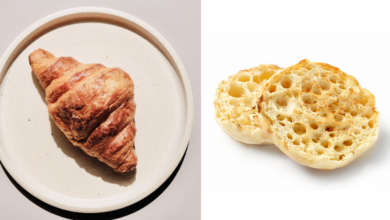Croissant Vs. White Bread: The Great Taste Test

What To Know
- Over the centuries, white bread has become a staple food in many cultures around the world, serving as a versatile base for sandwiches, toast, and various culinary creations.
- White bread is a good source of carbohydrates, primarily in the form of refined flour, which can provide quick energy but may not be as satiating as other complex carbohydrates.
- White bread is a classic choice for sandwiches, providing a neutral base for a wide range of fillings, from deli meats and cheese to vegetables and spreads.
In the realm of breakfast staples, two contenders stand tall: the buttery, flaky croissant and the humble white bread. While both have their dedicated fans, the debate over which one reigns supreme continues to ignite heated discussions among breakfast enthusiasts. In this comprehensive guide, we’ll delve into the world of croissants and white bread, exploring their origins, nutritional profiles, taste, texture, and versatility. By the end of this epic showdown, you’ll have all the knowledge you need to make an informed decision about your next breakfast choice.
Origin and History: A Journey Through Time
The croissant, with its distinctive crescent shape, traces its roots back to the 19th century in Austria, where it was known as kipferi. However, it wasn’t until the 20th century that the croissant gained widespread popularity in France, becoming an integral part of the country’s breakfast culture.
White bread, on the other hand, has a much longer and diverse history. Its origins can be traced back to ancient civilizations, with evidence suggesting its existence in Egypt as early as 2000 BC. Over the centuries, white bread has become a staple food in many cultures around the world, serving as a versatile base for sandwiches, toast, and various culinary creations.
Nutritional Showdown: Unveiling the Health Benefits
When it comes to nutrition, both croissants and white bread have their own strengths and weaknesses.
Croissants:
- Calories: A single croissant typically contains around 270 calories, making it a more calorie-dense option compared to white bread.
- Fat: Croissants are higher in fat content, with a significant portion coming from saturated fats, which can contribute to heart health concerns if consumed in excess.
- Carbohydrates: Croissants provide a moderate amount of carbohydrates, primarily in the form of refined flour, which can lead to rapid spikes in blood sugar levels.
- Protein: Croissants are not a significant source of protein, offering a minimal amount per serving.
White Bread:
- Calories: A slice of white bread typically contains around 75 calories, making it a lower-calorie option compared to croissants.
- Fat: White bread is generally lower in fat content, with most of it coming from unsaturated fats, which are considered healthier for heart health.
- Carbohydrates: White bread is a good source of carbohydrates, primarily in the form of refined flour, which can provide quick energy but may not be as satiating as other complex carbohydrates.
- Protein: Similar to croissants, white bread is not a significant source of protein.
Taste and Texture: A Sensory Experience
The taste and texture of croissants and white bread offer distinct experiences.
Croissants:
- Taste: Croissants are known for their rich, buttery flavor, with hints of sweetness and a slightly salty finish.
- Texture: The croissant’s flaky layers create a light and airy texture that melts in your mouth.
White Bread:
- Taste: White bread has a mild, neutral flavor that makes it a versatile accompaniment to various toppings and fillings.
- Texture: White bread is typically soft and fluffy, providing a comforting and familiar texture.
Versatility in the Culinary World: Beyond Breakfast
Croissants and white bread extend their culinary reach beyond the breakfast table.
Croissants:
- Sandwiches: Croissants can be transformed into delectable breakfast or lunch sandwiches, filled with savory ingredients like eggs, cheese, bacon, or smoked salmon.
- Desserts: Croissants can be filled with sweet fillings like chocolate, jam, or custard, making them a delightful treat for any occasion.
- Appetizers: Croissants can be cut into small pieces and served as bite-sized appetizers, topped with various savory or sweet ingredients.
White Bread:
- Sandwiches: White bread is a classic choice for sandwiches, providing a neutral base for a wide range of fillings, from deli meats and cheese to vegetables and spreads.
- Toast: White bread can be toasted to create a crispy and golden-brown surface, perfect for serving with butter, jam, or avocado.
- Croutons: White bread can be cut into cubes and toasted to make croutons, adding a crunchy texture to salads and soups.
Choosing the Winner: A Matter of Personal Preference
Ultimately, the choice between croissants and white bread comes down to personal preference. If you prefer a rich, buttery flavor and a flaky texture, croissants might be your go-to choice. However, if you’re looking for a versatile and affordable option with a mild flavor and soft texture, white bread may be the better fit.
The Verdict: A Harmony of Flavors and Textures
In the grand scheme of breakfast staples, both croissants and white bread have a place at the table. While they offer distinct experiences in terms of taste, texture, and nutritional content, they can coexist harmoniously in a balanced diet. Enjoying croissants occasionally as a special treat and incorporating white bread into your meals in moderation can provide a delightful and varied breakfast experience.
Beyond the Showdown: Embracing Diversity in Breakfast Choices
The croissant vs white bread debate is just one example of the diverse and ever-evolving world of breakfast options. From hearty oatmeal to protein-packed yogurt parfaits and refreshing fruit smoothies, there’s a vast array of choices to cater to different tastes and dietary needs. Embrace the culinary adventure and explore the endless possibilities that breakfast has to offer.
Popular Questions
1. Which one is healthier, croissants or white bread?
Neither croissants nor white bread are inherently healthier. Both contain refined flour and have a high glycemic index, which can lead to rapid spikes in blood sugar levels. However, croissants are generally higher in calories, fat, and saturated fat compared to white bread.
2. Can I eat croissants or white bread on a diet?
If you’re following a weight loss or specific diet, it’s essential to consume croissants and white bread in moderation due to their high glycemic index and potential impact on blood sugar levels. Consider opting for whole-grain bread or healthier breakfast alternatives like oatmeal or yogurt.
3. What are some healthier alternatives to croissants and white bread?
For a healthier breakfast choice, consider opting for whole-grain bread, which is higher in fiber and nutrients compared to refined flour. Whole-grain bread can help regulate blood sugar levels and provide a feeling of fullness for longer. Additionally, you can explore other breakfast options like oatmeal, yogurt parfaits with fresh fruits and nuts, or protein smoothies.





